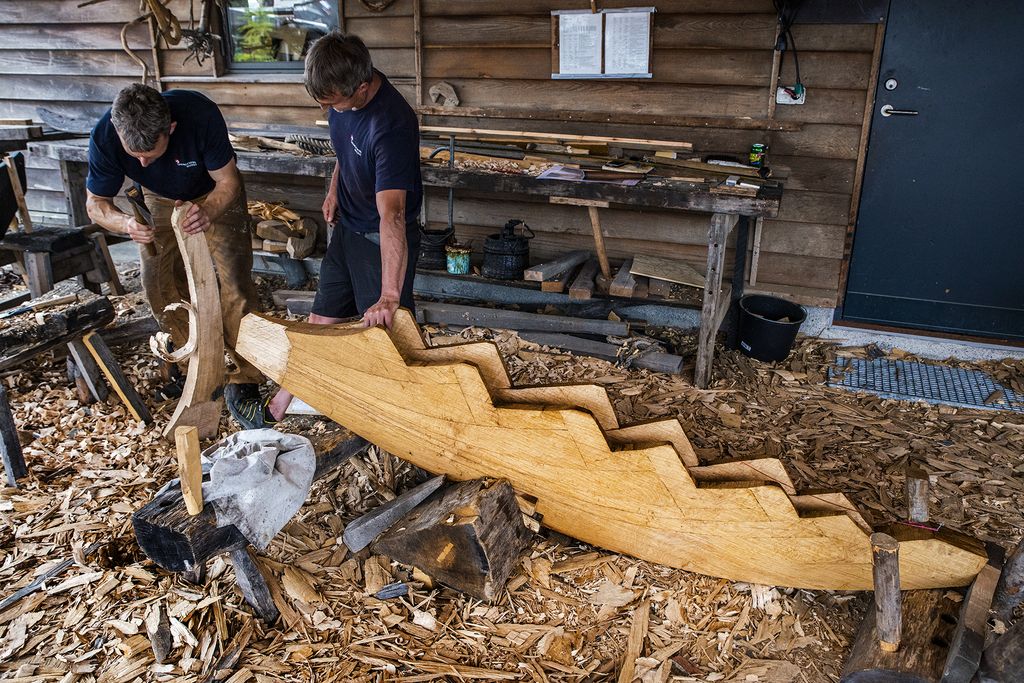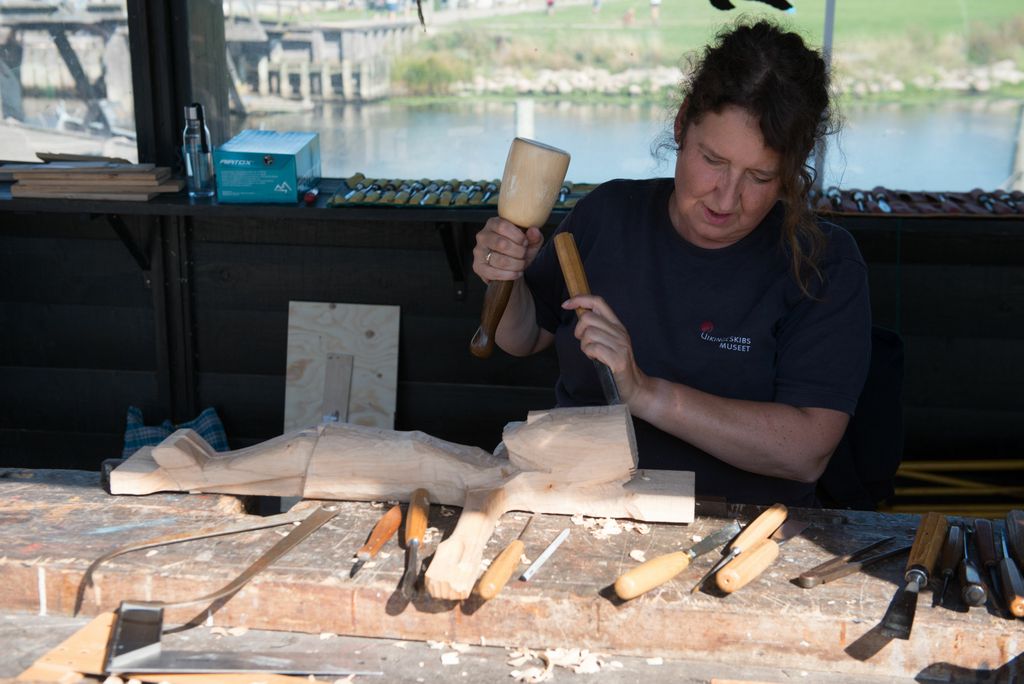
Meet the craftspeople
In the middle of the museum island you will find the boatyard. Here the building of reconstructions of Viking ships and other traditional wooden boats year round by the boatbuilders take place throughout the year.
During late spring and summer, we will widen our focus and present various maritime crafts of the Viking Age. During this time guests at the museum can experience the ancient crafts, methods and techniques being brought to life.
Depending on when you visit the Viking Ship Museum, you can engage in warrior training, meet the blacksmith, the ropemaker, the sailmaker, the woodcarver, or the charcoal burner.
Experience the beautiful maritime craftship at the museum every day from 10:00 - 17:00.
When can you meet the craftsmen?
May | June | July | August | |
The Boat builder | 1-31 | 1-30 | 1-31 | 1-31 |
The Blacksmith | 2 - 4, 10 - 11, 16 - 17, 23 - 25 and 30 | 1 - 8, 13, 22 - 23, 26 - 29 and 31 | 4 - 7, 11 - 14, 16 - 17, 20, 22, 24 - 25 and 28 | |
The Sailmaker | 3 - 4, 10 - 11, 24 – 25 and 31 | 1, 14 - 15, 21 - 22 and 28 – 29 | 21 - 22 and 26 – 27 | |
The Ropemaker | 1 and 29 – 30 | 12 - 13, 19 – 20 and 26 – 27 | 9 - 11 and 24 - 25 | 7 - 8, 14 – 15 and 28 - 29 |
The Woodcarver | 17 – 18 | 7 – 9 and 18 | 10, 12, 21 and 28 – 30 | 18 – 19 and 23 |
The Viking warrior | 14 - 20 | |||
The Charcoal burner | 8 - 10 |
The Boatbuilders at the boatyard
In the middle of the museum island you will find the boatyard. Here the boatbuilders are working on reconstructions of Viking ships and other traditional wooden boats.
The scent of fresh pine tar fills the air, and the rhythmic sound of the boatbuilder's axe against the oak tree echoes rhythmically across the yard.
The boatbuilders are working on a new Viking Age warship Skuldelev 5, which is exhibited in the Viking Ship Hall. During the guided tour at the boatyard, the boatbuilders will explain and demonstrate the special techniques used by the Vikings when building their impressive ships.
At the boatyard a dedicated area is reserved for our guests to test out their own boatbuilding skills in the 'Build-a-Boat Workshop'.
Rope making in the ropemakers workshop
Rope making is one of the oldest crafts in the world, and many of the techniques and tools used in the museum's rope-making workshop have not changed much since the Viking Age.
Everything indicates that lime bast was the primary material in the Viking Age, supplemented with ropes made of spruce and other plants, skins (from walrus, seal, elk, deer, or ox), hair (from horses, cow tails, or pigs), and wool.
Throughout the summer, you can meet one of the craftspeople, who is skilled in several of the traditional materials and techniques for making ropes.
This summer, he is continuously working on bands for the oars of the Skuldelev 5 ship, which is being built at the boatyard.
The charcoal burners on the Beach Meadow
Burning charcoal and extracting pine-wood tar is an ancient craft that is essential in the construction of Viking Age ships. Pine-wood tar and charcoal are prerequisites for the blacksmith's work and the maintenance of the wood on the finished Viking ship.
To produce charcoal and pine-wood tar, resinous pine wood from the tree's trunks, branches, and roots is split into small sticks and carefully stacked in a so-called 'kiln'. The entire kiln is covered with peat and ignited. It must then be tended constantly for several days while it burns. During the controlled burning, the tar is driven out of the wood as a byproduct of the charcoal production process.
It is a very special experience when the charcoal burners open their kilns and the black gold emerges from the smoke and fumes in front of the Viking Ship Museum.
The blacksmith
Iron is probably not the first material that comes to mind when you see a Viking ship. However, it is iron nails and wooden pegs that hold the ships together, making the blacksmith's work a crucial part of the boatbuilding process.
When you meet the blacksmith at the museum, you get an insight into the difficult art of handling the red-hot iron.
This summer, you can experience the blacksmiths sweating over the fire as they make anchor chains for the anchor that was made last year for the Skuldelev 5 ship, which is being built at the boatyard.
Perhaps you can help with the bellows and have a chat about the exciting process of forging iron into nails, anchor chains and Viking Age tools.
The sailmaker in the ropemakers workshop
It was the ability to build seaworthy, sail-powered ships and navigate them on the open sea that gave rise to the Viking Age.
During the Viking Age, a sail had enormous value, since producing it required a great amount of manpower– from gathering the sheep wool or processing flax fibres, to spinning the thread, weaving the long panels of cloth and sewing them together as the finished sailcloth
Once the finished sailcloth is woven and the ropemaker has made the rigging for the sail, the sailmaker takes over the task of sewing ropes along the edges and completing the sail.
Meet the sailmakers in the Ropemakers Workshop on the museum island throughout the summer, where they will be repairing the sails of our Viking Ships.
The Woodcarver
Many objects from the Viking Age are richly decorated with beautiful wood carvings. This also applies to the Viking ships, which are sometimes adorned with elaborate heads and tails.
On the Skuldelev 5 ship, which is exhibited in the Viking Ship Hall, you can find a small remnant of decoration on one side of the ship - if you look closely.
In the Viking Age, the skilled craftsmen who could transform wood into imaginative and beautiful figures were probably called 'woodcarvers'.
Throughout the summer our guests will meet the woodcarver while she is creating various carvings that will be used for the new reconstruction of the Skuldelev 5 warship, which is being built at the boatyard.
The Viking warrior at the Beach Meadow
War, combat, and sharp weapons are some of the things most people associate with Viking ships and their expeditions around the world.
The art of war was an essential craft that one had to learn and train in order to become the best warrior and thus hope to return home to the family after these Viking Age expedition.
Most Viking warriors were equipped with an axe and a shield, while the chieftain could have expensive weapons such as a sword, helmet, and chainmail.
This summer, the Viking warrior will visit and showcase his impressive weapons and demonstrate how to use them.






